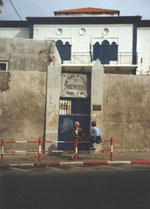
|
 |
| The Andraos sisters, Jaffa, April 1999. Photo: Leena Saraste |
| Leila, Widad, Suad Andraos, April 18:
|
 |
| The Andraos sisters, Jaffa, April 1999. Photo: Leena Saraste |
|
Andre suggests we visit an unusual family of three sisters who live alone in the villa their father built not long before 1948. It's in the same general area as Umm Nakhleh's home, but nearer to the sea and the old Jaffa cemetery. This was an area that was beginning to attract wealthy Jaffa-ites in the 1930s. When the attack against Jaffa started, their father refused to leave his house or his city, but sent his young children with an aunt in a car to Ramallah. He was the only member of Jaffa's Municipal Council who stayed behind. Like many Palestinian men who remained, it wasn't just his house he refused to leave but his mother, too old to make the difficult journey to 'safety'.
When the fighting ended, their father made several attempts to smuggle his children back to Jaffa, and finally succeeded in obtaining a 'family reunification' permit. Back in Jaffa, the three girls and their brother found their old Scotch school transformed. Now their teachers and schoolmates were Israeli; the teaching was in Hebrew and so were the text books. All their former friends and neighbours had left. Theirs was one of the few well-known Jaffa families left in Jaffa. Old friends and neighbours would visit much later, after the 1967 war, but as the Andraos girls grew up they had only themselves for company. All three of them did well in school, and found jobs in teaching or school administration. Suad, the youngest, became British Consul in Jaffa. 
Jaffa, gateway of the Tabeetha school, where the Andraos sisters went to school. The sisters tell us about Jewish neighbours who continually cut down their hedge. Years later, when the neighbour was dying, he confessed to them that he and his wife had been given the house free in return for keeping watch on the Andraos household. Israelis have made many attempts to buy their house, but the sisters have always refused, wanting to keep it as a memorial to their father. The problem of lack of heirs to continue guardianship isn't raised - the atmosphere of a social tea party prevents such serious topics. After the recording session is over, they show us the architect's blueprint of the villa, planned by their father after a trip to Egypt, and intended as a wedding gift to |
their mother who loved everything Egyptian.
Their home is an inheritance made more precious by the threats to it. Under Israeli law, you can't do anything with a house - not build, not sell, not change, not bequeath - without permission from the state. If a member of the family that owns it happens to die outside Israel, the state takes that member's inheritance of house or land. Few other states in the world has such powers over private property as Israel. Reinforced by constant repetition amongst themselves, the sisters' stories have the effortless spontaneity of a good stage performance. They don't - as often happens in group recordings - contradict or argue with each other, but rather recall to each other treasured bits of repertoire. As Andre says afterwards, it's a perfect case of collectively constructed memory. The sisters choose to speak in English, and speak in turn, beginning with the youngest, Suad, who vividly recreates the sensations of a young child suddenly leaving home in an atmosphere of crisis.
Suad Andraos begins to speak: |
 |
| The Andraos sisters, Jaffa, April 1999. Photo: Leena Saraste |
[Umm Nakhleh Saqar] [To Jaffa, April 18] Copyright©2005 |
|